An In-Depth Literature Review: Corporate Social Responsibility (CSR)
VerifiedAdded on 2020/12/08
|10
|2580
|147
Essay
AI Summary
This essay presents a comprehensive literature review on Corporate Social Responsibility (CSR). It begins by defining literature reviews and their importance, then delves into the core concepts of CSR, including its benefits to organizations, such as financial growth, enhanced employee loyalty, and a positive company image. The review explores various CSR initiatives, including environmental sustainability, community involvement, and online business practices. It examines the impact of CSR on poverty reduction, competitive advantages, and improved brand image. The essay also discusses mandatory and voluntary aspects of CSR, emphasizing its significance for employees, shareholders, and investors. The review highlights the role of CSR in long-term growth, ethical behavior, and employee satisfaction. It references standards and guidelines for implementing CSR activities and concludes by summarizing the key findings and emphasizing the importance of CSR for business operations and stakeholder relationships. The essay also highlights the importance of CSR in business operations and stakeholder relationships, drawing on various sources to support its arguments and provide a comprehensive overview of the subject.

Individual essay
Paraphrase This Document
Need a fresh take? Get an instant paraphrase of this document with our AI Paraphraser

Table of Contents
INTRODUCTION...........................................................................................................................1
MAIN BODY...................................................................................................................................1
1. About literature review...........................................................................................................1
2. Literature review on the topic of “ Corporate social responsibility”......................................3
CONCLUSION................................................................................................................................5
REFERENCES................................................................................................................................7
INTRODUCTION...........................................................................................................................1
MAIN BODY...................................................................................................................................1
1. About literature review...........................................................................................................1
2. Literature review on the topic of “ Corporate social responsibility”......................................3
CONCLUSION................................................................................................................................5
REFERENCES................................................................................................................................7
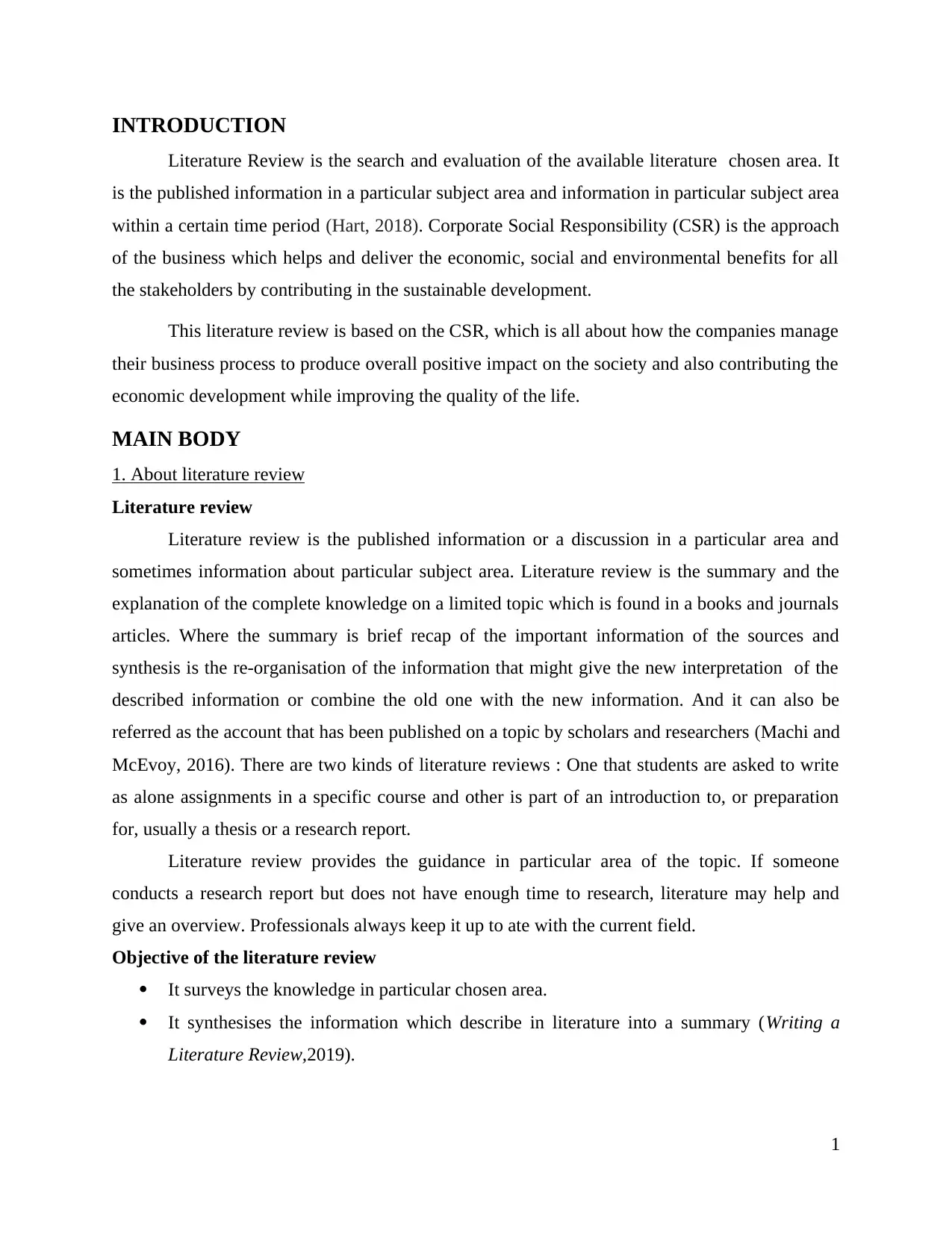
INTRODUCTION
Literature Review is the search and evaluation of the available literature chosen area. It
is the published information in a particular subject area and information in particular subject area
within a certain time period (Hart, 2018). Corporate Social Responsibility (CSR) is the approach
of the business which helps and deliver the economic, social and environmental benefits for all
the stakeholders by contributing in the sustainable development.
This literature review is based on the CSR, which is all about how the companies manage
their business process to produce overall positive impact on the society and also contributing the
economic development while improving the quality of the life.
MAIN BODY
1. About literature review
Literature review
Literature review is the published information or a discussion in a particular area and
sometimes information about particular subject area. Literature review is the summary and the
explanation of the complete knowledge on a limited topic which is found in a books and journals
articles. Where the summary is brief recap of the important information of the sources and
synthesis is the re-organisation of the information that might give the new interpretation of the
described information or combine the old one with the new information. And it can also be
referred as the account that has been published on a topic by scholars and researchers (Machi and
McEvoy, 2016). There are two kinds of literature reviews : One that students are asked to write
as alone assignments in a specific course and other is part of an introduction to, or preparation
for, usually a thesis or a research report.
Literature review provides the guidance in particular area of the topic. If someone
conducts a research report but does not have enough time to research, literature may help and
give an overview. Professionals always keep it up to ate with the current field.
Objective of the literature review
It surveys the knowledge in particular chosen area.
It synthesises the information which describe in literature into a summary (Writing a
Literature Review,2019).
1
Literature Review is the search and evaluation of the available literature chosen area. It
is the published information in a particular subject area and information in particular subject area
within a certain time period (Hart, 2018). Corporate Social Responsibility (CSR) is the approach
of the business which helps and deliver the economic, social and environmental benefits for all
the stakeholders by contributing in the sustainable development.
This literature review is based on the CSR, which is all about how the companies manage
their business process to produce overall positive impact on the society and also contributing the
economic development while improving the quality of the life.
MAIN BODY
1. About literature review
Literature review
Literature review is the published information or a discussion in a particular area and
sometimes information about particular subject area. Literature review is the summary and the
explanation of the complete knowledge on a limited topic which is found in a books and journals
articles. Where the summary is brief recap of the important information of the sources and
synthesis is the re-organisation of the information that might give the new interpretation of the
described information or combine the old one with the new information. And it can also be
referred as the account that has been published on a topic by scholars and researchers (Machi and
McEvoy, 2016). There are two kinds of literature reviews : One that students are asked to write
as alone assignments in a specific course and other is part of an introduction to, or preparation
for, usually a thesis or a research report.
Literature review provides the guidance in particular area of the topic. If someone
conducts a research report but does not have enough time to research, literature may help and
give an overview. Professionals always keep it up to ate with the current field.
Objective of the literature review
It surveys the knowledge in particular chosen area.
It synthesises the information which describe in literature into a summary (Writing a
Literature Review,2019).
1
⊘ This is a preview!⊘
Do you want full access?
Subscribe today to unlock all pages.

Trusted by 1+ million students worldwide

Information is being critically analysed which is gathered by identifying the gaps in
current knowledge.
And it presents the literature in organised way.
Purpose of the literature Review
It provides the easy access to readers in research on a participate area of subject by
selecting the high quality articles or studies which are relevant, meaningful, valid and
important and summarize these research in single report.
It also ensures that the work which is already been done no to duplicate by researchers.
It highlights the key findings (Vagia, Transeth and Fjerdingen, 2016).
It identifies the gaps, inconsistencies and contradictions in the literature.
It also provides the constructive analysis of the methodology and approaches of other
researchers.
Contents of the Literature Review
Introduction – Introduction explains the importance of the subject and also discuss that
w hat kind of work has been done on the particular topic. Introduction will also suggest
how the review findings will lead the research.
Body – Body is divided in some headings and subheadings. The body summarize and
evaluate the current state of the knowledge in a particular field. It include the important
topics, finding about the researchers that agree or disagree. The purpose of the body is to
make an argument that will justify the proposed researcher (Writing a Literature
Review,2019).
Conclusion – Conclusion summarize all the evidence presented below in the above main
body. It highlights the gaps and indicate how previous research will lead to the project
and chosen methodology.
Importance of the literature review
Literature review provide the support to the research. It provide the supportive proof of
the arguments and claim and also work as a strong background of the investigation.
Literature review also helps in developing theoretical framework.
It helps to handle the methodology and designing the issue by showing the other scholars.
Literature review helps to enable the researchers to become expert and specialist in the
specific area (Machi and McEvoy, 2016).
2
current knowledge.
And it presents the literature in organised way.
Purpose of the literature Review
It provides the easy access to readers in research on a participate area of subject by
selecting the high quality articles or studies which are relevant, meaningful, valid and
important and summarize these research in single report.
It also ensures that the work which is already been done no to duplicate by researchers.
It highlights the key findings (Vagia, Transeth and Fjerdingen, 2016).
It identifies the gaps, inconsistencies and contradictions in the literature.
It also provides the constructive analysis of the methodology and approaches of other
researchers.
Contents of the Literature Review
Introduction – Introduction explains the importance of the subject and also discuss that
w hat kind of work has been done on the particular topic. Introduction will also suggest
how the review findings will lead the research.
Body – Body is divided in some headings and subheadings. The body summarize and
evaluate the current state of the knowledge in a particular field. It include the important
topics, finding about the researchers that agree or disagree. The purpose of the body is to
make an argument that will justify the proposed researcher (Writing a Literature
Review,2019).
Conclusion – Conclusion summarize all the evidence presented below in the above main
body. It highlights the gaps and indicate how previous research will lead to the project
and chosen methodology.
Importance of the literature review
Literature review provide the support to the research. It provide the supportive proof of
the arguments and claim and also work as a strong background of the investigation.
Literature review also helps in developing theoretical framework.
It helps to handle the methodology and designing the issue by showing the other scholars.
Literature review helps to enable the researchers to become expert and specialist in the
specific area (Machi and McEvoy, 2016).
2
Paraphrase This Document
Need a fresh take? Get an instant paraphrase of this document with our AI Paraphraser
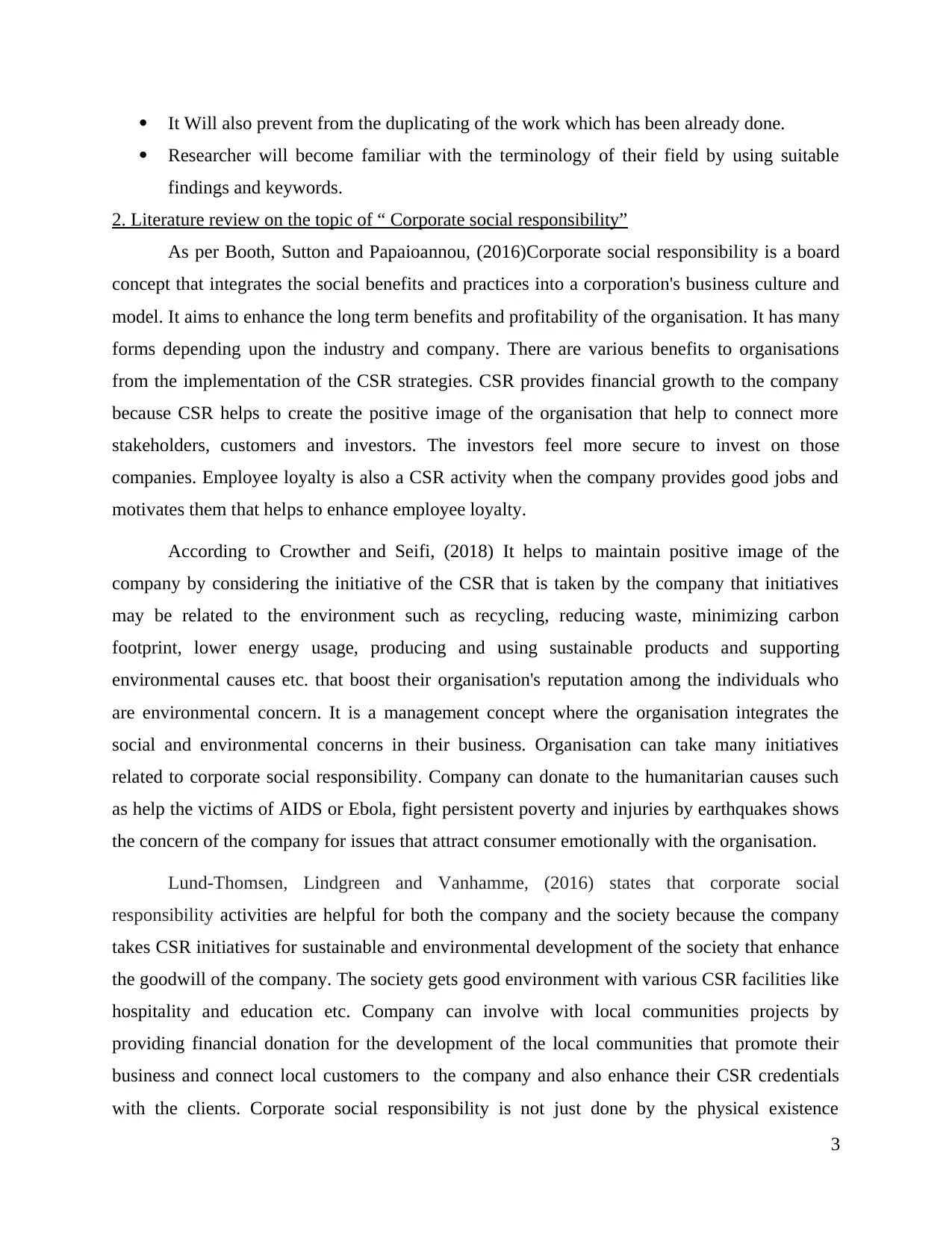
It Will also prevent from the duplicating of the work which has been already done.
Researcher will become familiar with the terminology of their field by using suitable
findings and keywords.
2. Literature review on the topic of “ Corporate social responsibility”
As per Booth, Sutton and Papaioannou, (2016)Corporate social responsibility is a board
concept that integrates the social benefits and practices into a corporation's business culture and
model. It aims to enhance the long term benefits and profitability of the organisation. It has many
forms depending upon the industry and company. There are various benefits to organisations
from the implementation of the CSR strategies. CSR provides financial growth to the company
because CSR helps to create the positive image of the organisation that help to connect more
stakeholders, customers and investors. The investors feel more secure to invest on those
companies. Employee loyalty is also a CSR activity when the company provides good jobs and
motivates them that helps to enhance employee loyalty.
According to Crowther and Seifi, (2018) It helps to maintain positive image of the
company by considering the initiative of the CSR that is taken by the company that initiatives
may be related to the environment such as recycling, reducing waste, minimizing carbon
footprint, lower energy usage, producing and using sustainable products and supporting
environmental causes etc. that boost their organisation's reputation among the individuals who
are environmental concern. It is a management concept where the organisation integrates the
social and environmental concerns in their business. Organisation can take many initiatives
related to corporate social responsibility. Company can donate to the humanitarian causes such
as help the victims of AIDS or Ebola, fight persistent poverty and injuries by earthquakes shows
the concern of the company for issues that attract consumer emotionally with the organisation.
Lund-Thomsen, Lindgreen and Vanhamme, (2016) states that corporate social
responsibility activities are helpful for both the company and the society because the company
takes CSR initiatives for sustainable and environmental development of the society that enhance
the goodwill of the company. The society gets good environment with various CSR facilities like
hospitality and education etc. Company can involve with local communities projects by
providing financial donation for the development of the local communities that promote their
business and connect local customers to the company and also enhance their CSR credentials
with the clients. Corporate social responsibility is not just done by the physical existence
3
Researcher will become familiar with the terminology of their field by using suitable
findings and keywords.
2. Literature review on the topic of “ Corporate social responsibility”
As per Booth, Sutton and Papaioannou, (2016)Corporate social responsibility is a board
concept that integrates the social benefits and practices into a corporation's business culture and
model. It aims to enhance the long term benefits and profitability of the organisation. It has many
forms depending upon the industry and company. There are various benefits to organisations
from the implementation of the CSR strategies. CSR provides financial growth to the company
because CSR helps to create the positive image of the organisation that help to connect more
stakeholders, customers and investors. The investors feel more secure to invest on those
companies. Employee loyalty is also a CSR activity when the company provides good jobs and
motivates them that helps to enhance employee loyalty.
According to Crowther and Seifi, (2018) It helps to maintain positive image of the
company by considering the initiative of the CSR that is taken by the company that initiatives
may be related to the environment such as recycling, reducing waste, minimizing carbon
footprint, lower energy usage, producing and using sustainable products and supporting
environmental causes etc. that boost their organisation's reputation among the individuals who
are environmental concern. It is a management concept where the organisation integrates the
social and environmental concerns in their business. Organisation can take many initiatives
related to corporate social responsibility. Company can donate to the humanitarian causes such
as help the victims of AIDS or Ebola, fight persistent poverty and injuries by earthquakes shows
the concern of the company for issues that attract consumer emotionally with the organisation.
Lund-Thomsen, Lindgreen and Vanhamme, (2016) states that corporate social
responsibility activities are helpful for both the company and the society because the company
takes CSR initiatives for sustainable and environmental development of the society that enhance
the goodwill of the company. The society gets good environment with various CSR facilities like
hospitality and education etc. Company can involve with local communities projects by
providing financial donation for the development of the local communities that promote their
business and connect local customers to the company and also enhance their CSR credentials
with the clients. Corporate social responsibility is not just done by the physical existence
3
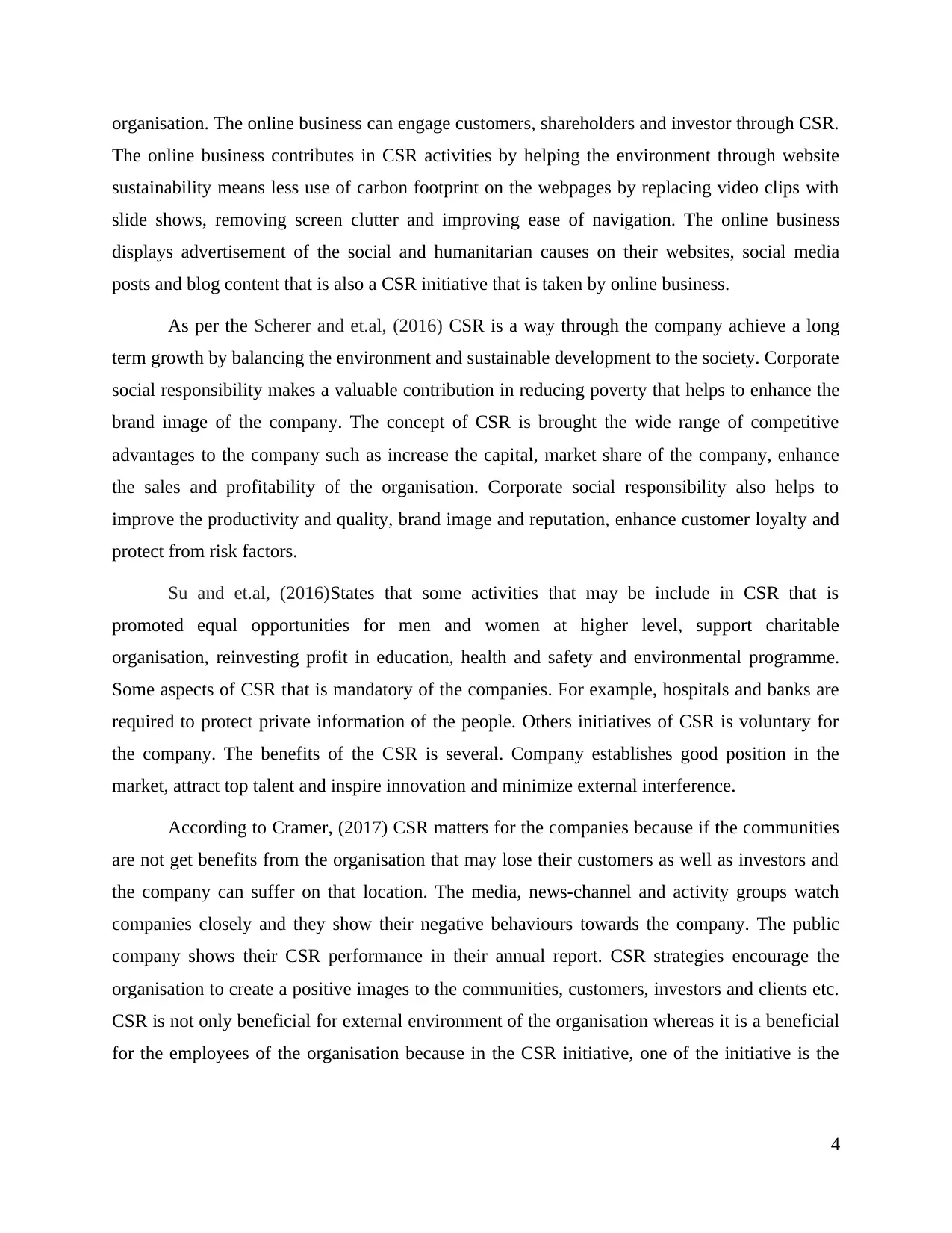
organisation. The online business can engage customers, shareholders and investor through CSR.
The online business contributes in CSR activities by helping the environment through website
sustainability means less use of carbon footprint on the webpages by replacing video clips with
slide shows, removing screen clutter and improving ease of navigation. The online business
displays advertisement of the social and humanitarian causes on their websites, social media
posts and blog content that is also a CSR initiative that is taken by online business.
As per the Scherer and et.al, (2016) CSR is a way through the company achieve a long
term growth by balancing the environment and sustainable development to the society. Corporate
social responsibility makes a valuable contribution in reducing poverty that helps to enhance the
brand image of the company. The concept of CSR is brought the wide range of competitive
advantages to the company such as increase the capital, market share of the company, enhance
the sales and profitability of the organisation. Corporate social responsibility also helps to
improve the productivity and quality, brand image and reputation, enhance customer loyalty and
protect from risk factors.
Su and et.al, (2016)States that some activities that may be include in CSR that is
promoted equal opportunities for men and women at higher level, support charitable
organisation, reinvesting profit in education, health and safety and environmental programme.
Some aspects of CSR that is mandatory of the companies. For example, hospitals and banks are
required to protect private information of the people. Others initiatives of CSR is voluntary for
the company. The benefits of the CSR is several. Company establishes good position in the
market, attract top talent and inspire innovation and minimize external interference.
According to Cramer, (2017) CSR matters for the companies because if the communities
are not get benefits from the organisation that may lose their customers as well as investors and
the company can suffer on that location. The media, news-channel and activity groups watch
companies closely and they show their negative behaviours towards the company. The public
company shows their CSR performance in their annual report. CSR strategies encourage the
organisation to create a positive images to the communities, customers, investors and clients etc.
CSR is not only beneficial for external environment of the organisation whereas it is a beneficial
for the employees of the organisation because in the CSR initiative, one of the initiative is the
4
The online business contributes in CSR activities by helping the environment through website
sustainability means less use of carbon footprint on the webpages by replacing video clips with
slide shows, removing screen clutter and improving ease of navigation. The online business
displays advertisement of the social and humanitarian causes on their websites, social media
posts and blog content that is also a CSR initiative that is taken by online business.
As per the Scherer and et.al, (2016) CSR is a way through the company achieve a long
term growth by balancing the environment and sustainable development to the society. Corporate
social responsibility makes a valuable contribution in reducing poverty that helps to enhance the
brand image of the company. The concept of CSR is brought the wide range of competitive
advantages to the company such as increase the capital, market share of the company, enhance
the sales and profitability of the organisation. Corporate social responsibility also helps to
improve the productivity and quality, brand image and reputation, enhance customer loyalty and
protect from risk factors.
Su and et.al, (2016)States that some activities that may be include in CSR that is
promoted equal opportunities for men and women at higher level, support charitable
organisation, reinvesting profit in education, health and safety and environmental programme.
Some aspects of CSR that is mandatory of the companies. For example, hospitals and banks are
required to protect private information of the people. Others initiatives of CSR is voluntary for
the company. The benefits of the CSR is several. Company establishes good position in the
market, attract top talent and inspire innovation and minimize external interference.
According to Cramer, (2017) CSR matters for the companies because if the communities
are not get benefits from the organisation that may lose their customers as well as investors and
the company can suffer on that location. The media, news-channel and activity groups watch
companies closely and they show their negative behaviours towards the company. The public
company shows their CSR performance in their annual report. CSR strategies encourage the
organisation to create a positive images to the communities, customers, investors and clients etc.
CSR is not only beneficial for external environment of the organisation whereas it is a beneficial
for the employees of the organisation because in the CSR initiative, one of the initiative is the
4
⊘ This is a preview!⊘
Do you want full access?
Subscribe today to unlock all pages.

Trusted by 1+ million students worldwide

employee welfare. Employees performance is directly effected the productivity, sales and profit
of organisation.
Frynas and Yamahaki, (2019) states The company increases their long term profits and
efficiency of the operation through CSR initiative. Those companies who adopt Corporate social
responsibility programmes have grown their business activities where they get back to the
society. CSR is a strategy for the large organisation to become a more successful and more
responsibilities towards the society. The company has to behave ethical with their competitors,
peers and industry etc. The organisation is mainly depended on their employees and employee
satisfaction and engagement is very important for running business operations that is only
possible when employees work in good working condition and flexibly working hour etc.
Organisation designs various corporate philanthropic plan for improving employees satisfaction
level and motivates them to work hard that enhance the efficiency of the employees.
As per the Vagia, Transeth and Fjerdingen, (2016) The international organization for
standardization is released voluntary standards for the company that help to implement CSR
activities. It provides the guidelines to the company about CSR because the nature of CSR
activities are qualitative rather than quantitative. The aim of the standard is provided regardless
of the CSR activities to the all types of the organisation. The corporate social responsibility is
also significant for the company to deal in loyally and fair manner with the shareholder, investors
and clients. It helps in the growth of the potential market share as well as profitability of the
organisation. The CSR is a crucial element for enhancing the sales and profit of the companies. It
also helps to make the long term sustainability of the organisation.
According to Machi and McEvoy, (2016) CSR is a significant activity of the organisation
which covers the gap between companies operations and customers and employees. Corporate
social responsibility increases the level of job satisfaction of the employees and also suggest
innovative ideas for the organisation. Corporate social responsibilities are helped to enhance the
business operations at international level. With the help of principles of CSR, organisation can
utilize their resources effectively and reduce the ideal time as well as negative impact of the
external environment. all organisations are used different approaches of the CSR. For example,
Starbucks achieves CSR milestones. Starbucks contributes millions of hours to providing
community services, pioneering green building on their all stores, creating global networks with
5
of organisation.
Frynas and Yamahaki, (2019) states The company increases their long term profits and
efficiency of the operation through CSR initiative. Those companies who adopt Corporate social
responsibility programmes have grown their business activities where they get back to the
society. CSR is a strategy for the large organisation to become a more successful and more
responsibilities towards the society. The company has to behave ethical with their competitors,
peers and industry etc. The organisation is mainly depended on their employees and employee
satisfaction and engagement is very important for running business operations that is only
possible when employees work in good working condition and flexibly working hour etc.
Organisation designs various corporate philanthropic plan for improving employees satisfaction
level and motivates them to work hard that enhance the efficiency of the employees.
As per the Vagia, Transeth and Fjerdingen, (2016) The international organization for
standardization is released voluntary standards for the company that help to implement CSR
activities. It provides the guidelines to the company about CSR because the nature of CSR
activities are qualitative rather than quantitative. The aim of the standard is provided regardless
of the CSR activities to the all types of the organisation. The corporate social responsibility is
also significant for the company to deal in loyally and fair manner with the shareholder, investors
and clients. It helps in the growth of the potential market share as well as profitability of the
organisation. The CSR is a crucial element for enhancing the sales and profit of the companies. It
also helps to make the long term sustainability of the organisation.
According to Machi and McEvoy, (2016) CSR is a significant activity of the organisation
which covers the gap between companies operations and customers and employees. Corporate
social responsibility increases the level of job satisfaction of the employees and also suggest
innovative ideas for the organisation. Corporate social responsibilities are helped to enhance the
business operations at international level. With the help of principles of CSR, organisation can
utilize their resources effectively and reduce the ideal time as well as negative impact of the
external environment. all organisations are used different approaches of the CSR. For example,
Starbucks achieves CSR milestones. Starbucks contributes millions of hours to providing
community services, pioneering green building on their all stores, creating global networks with
5
Paraphrase This Document
Need a fresh take? Get an instant paraphrase of this document with our AI Paraphraser
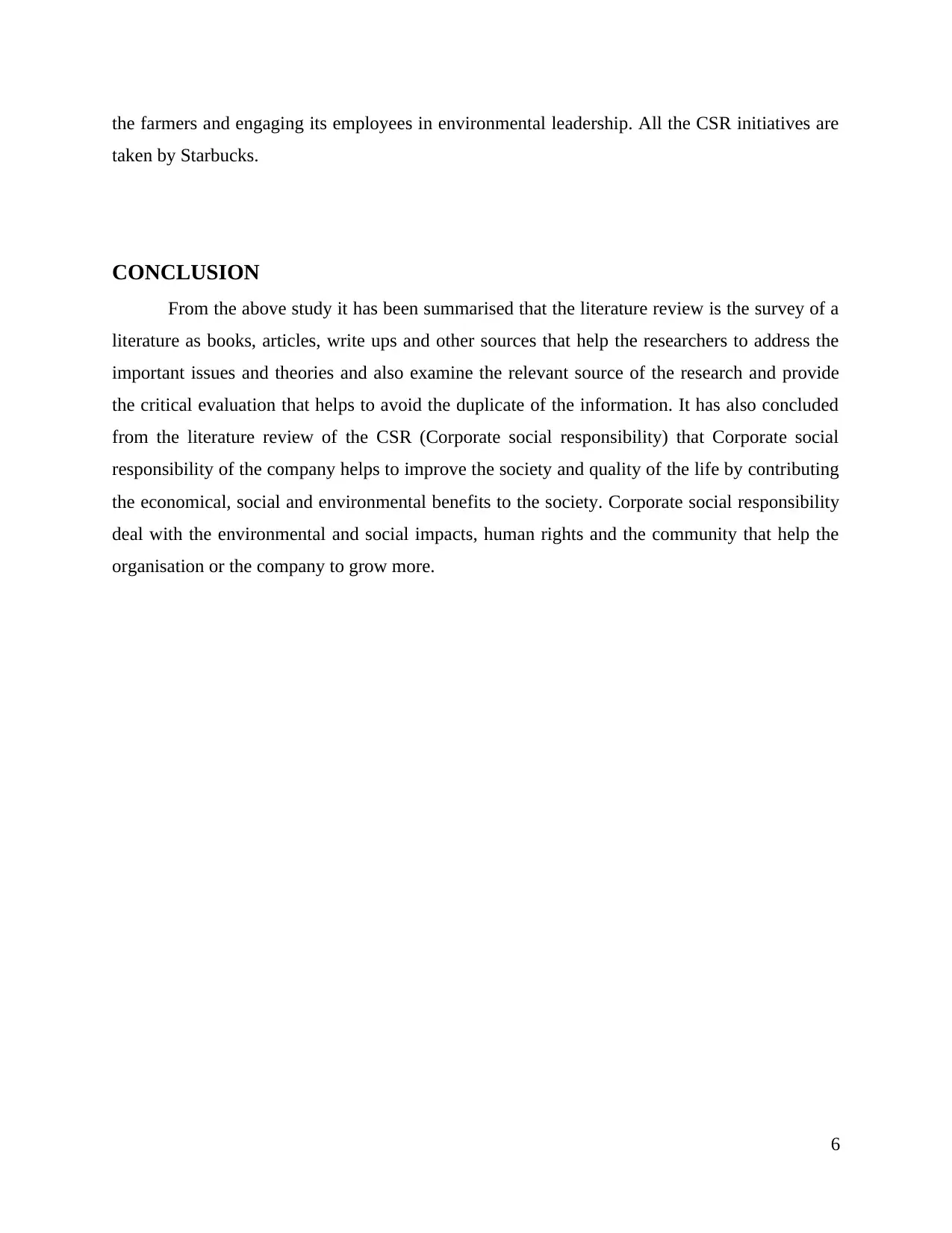
the farmers and engaging its employees in environmental leadership. All the CSR initiatives are
taken by Starbucks.
CONCLUSION
From the above study it has been summarised that the literature review is the survey of a
literature as books, articles, write ups and other sources that help the researchers to address the
important issues and theories and also examine the relevant source of the research and provide
the critical evaluation that helps to avoid the duplicate of the information. It has also concluded
from the literature review of the CSR (Corporate social responsibility) that Corporate social
responsibility of the company helps to improve the society and quality of the life by contributing
the economical, social and environmental benefits to the society. Corporate social responsibility
deal with the environmental and social impacts, human rights and the community that help the
organisation or the company to grow more.
6
taken by Starbucks.
CONCLUSION
From the above study it has been summarised that the literature review is the survey of a
literature as books, articles, write ups and other sources that help the researchers to address the
important issues and theories and also examine the relevant source of the research and provide
the critical evaluation that helps to avoid the duplicate of the information. It has also concluded
from the literature review of the CSR (Corporate social responsibility) that Corporate social
responsibility of the company helps to improve the society and quality of the life by contributing
the economical, social and environmental benefits to the society. Corporate social responsibility
deal with the environmental and social impacts, human rights and the community that help the
organisation or the company to grow more.
6
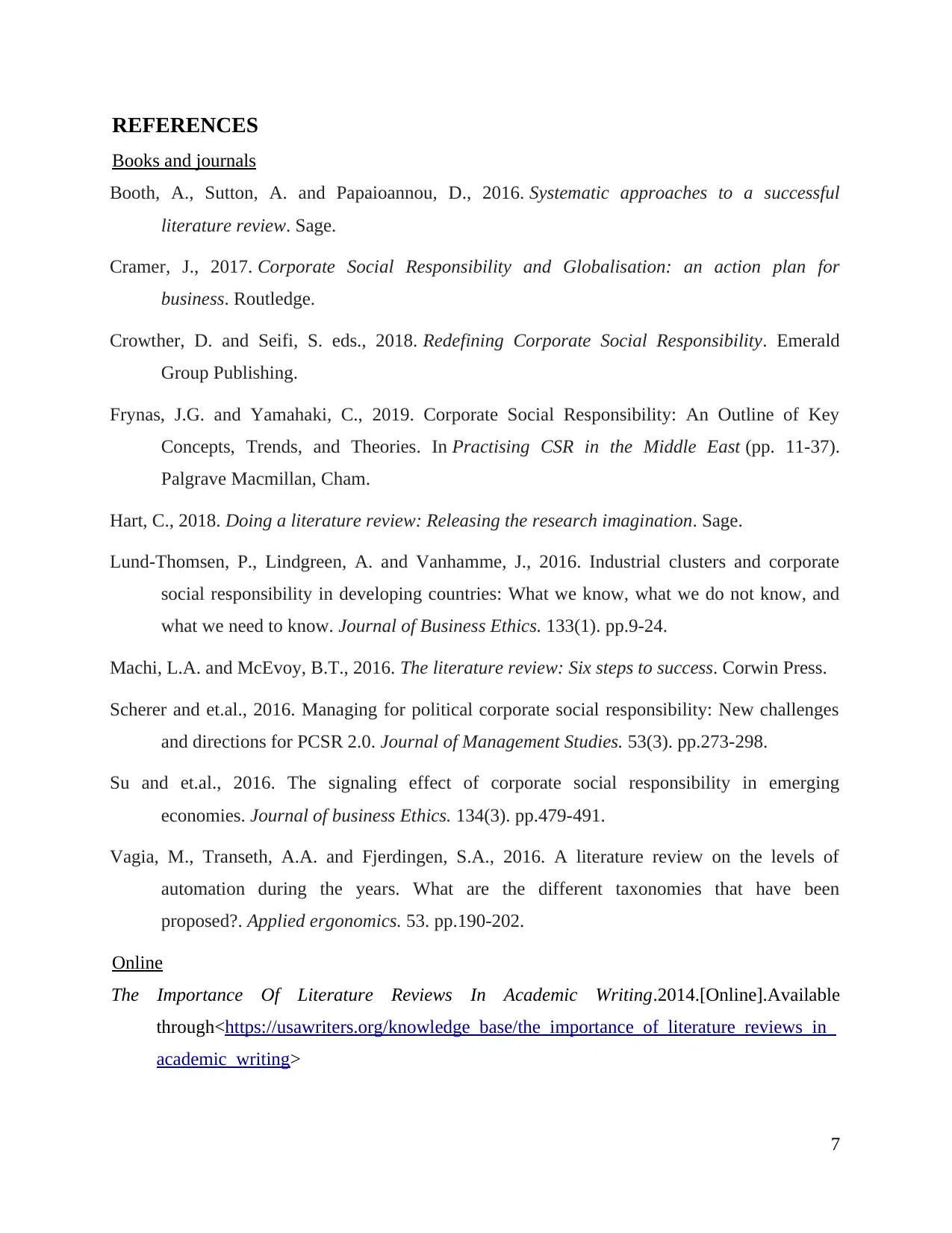
REFERENCES
Books and journals
Booth, A., Sutton, A. and Papaioannou, D., 2016. Systematic approaches to a successful
literature review. Sage.
Cramer, J., 2017. Corporate Social Responsibility and Globalisation: an action plan for
business. Routledge.
Crowther, D. and Seifi, S. eds., 2018. Redefining Corporate Social Responsibility. Emerald
Group Publishing.
Frynas, J.G. and Yamahaki, C., 2019. Corporate Social Responsibility: An Outline of Key
Concepts, Trends, and Theories. In Practising CSR in the Middle East (pp. 11-37).
Palgrave Macmillan, Cham.
Hart, C., 2018. Doing a literature review: Releasing the research imagination. Sage.
Lund-Thomsen, P., Lindgreen, A. and Vanhamme, J., 2016. Industrial clusters and corporate
social responsibility in developing countries: What we know, what we do not know, and
what we need to know. Journal of Business Ethics. 133(1). pp.9-24.
Machi, L.A. and McEvoy, B.T., 2016. The literature review: Six steps to success. Corwin Press.
Scherer and et.al., 2016. Managing for political corporate social responsibility: New challenges
and directions for PCSR 2.0. Journal of Management Studies. 53(3). pp.273-298.
Su and et.al., 2016. The signaling effect of corporate social responsibility in emerging
economies. Journal of business Ethics. 134(3). pp.479-491.
Vagia, M., Transeth, A.A. and Fjerdingen, S.A., 2016. A literature review on the levels of
automation during the years. What are the different taxonomies that have been
proposed?. Applied ergonomics. 53. pp.190-202.
Online
The Importance Of Literature Reviews In Academic Writing.2014.[Online].Available
through<https://usawriters.org/knowledge_base/the_importance_of_literature_reviews_in_
academic_writing>
7
Books and journals
Booth, A., Sutton, A. and Papaioannou, D., 2016. Systematic approaches to a successful
literature review. Sage.
Cramer, J., 2017. Corporate Social Responsibility and Globalisation: an action plan for
business. Routledge.
Crowther, D. and Seifi, S. eds., 2018. Redefining Corporate Social Responsibility. Emerald
Group Publishing.
Frynas, J.G. and Yamahaki, C., 2019. Corporate Social Responsibility: An Outline of Key
Concepts, Trends, and Theories. In Practising CSR in the Middle East (pp. 11-37).
Palgrave Macmillan, Cham.
Hart, C., 2018. Doing a literature review: Releasing the research imagination. Sage.
Lund-Thomsen, P., Lindgreen, A. and Vanhamme, J., 2016. Industrial clusters and corporate
social responsibility in developing countries: What we know, what we do not know, and
what we need to know. Journal of Business Ethics. 133(1). pp.9-24.
Machi, L.A. and McEvoy, B.T., 2016. The literature review: Six steps to success. Corwin Press.
Scherer and et.al., 2016. Managing for political corporate social responsibility: New challenges
and directions for PCSR 2.0. Journal of Management Studies. 53(3). pp.273-298.
Su and et.al., 2016. The signaling effect of corporate social responsibility in emerging
economies. Journal of business Ethics. 134(3). pp.479-491.
Vagia, M., Transeth, A.A. and Fjerdingen, S.A., 2016. A literature review on the levels of
automation during the years. What are the different taxonomies that have been
proposed?. Applied ergonomics. 53. pp.190-202.
Online
The Importance Of Literature Reviews In Academic Writing.2014.[Online].Available
through<https://usawriters.org/knowledge_base/the_importance_of_literature_reviews_in_
academic_writing>
7
⊘ This is a preview!⊘
Do you want full access?
Subscribe today to unlock all pages.

Trusted by 1+ million students worldwide

Writing a Literature Review.2019.[Online].Available through<https://www.lib.uoguelph.ca/get-
assistance/writing/specific-types-papers/writing-literature-review>
8
assistance/writing/specific-types-papers/writing-literature-review>
8
1 out of 10
Related Documents
Your All-in-One AI-Powered Toolkit for Academic Success.
+13062052269
info@desklib.com
Available 24*7 on WhatsApp / Email
![[object Object]](/_next/static/media/star-bottom.7253800d.svg)
Unlock your academic potential
Copyright © 2020–2025 A2Z Services. All Rights Reserved. Developed and managed by ZUCOL.





